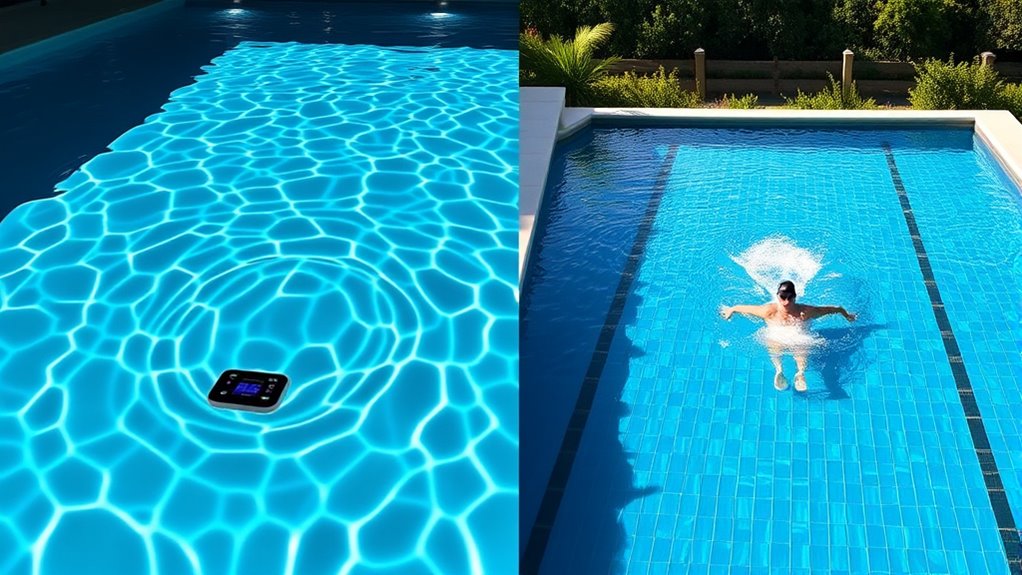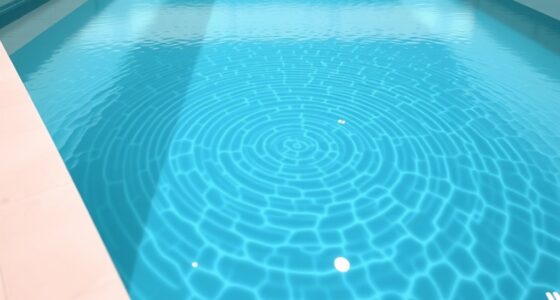Choosing between an endless pool and a lap pool depends on your space, budget, and lifestyle. Endless pools are compact, affordable, and easy to install, perfect for casual swimming, therapy, or small spaces. Lap pools are longer, suited for serious training and athletes, but cost more and take longer to set up. To find out which fits your needs best and enjoy the benefits each offers, explore more options ahead.
Key Takeaways
- Endless pools are compact, affordable, and quick to install, ideal for small spaces and casual or low-impact swimming.
- Lap pools offer larger, specialized lanes for serious training, endurance, and competitive swimming, but require more space and higher costs.
- Endless pools typically have lower maintenance and operating costs due to smaller size and integrated systems.
- Lap pools provide a dedicated environment for focused workouts but involve higher initial investment, installation time, and ongoing expenses.
- Choose an endless pool for versatility and space-saving convenience; opt for a lap pool if serious training and longer swimming sessions are priorities.
Design and Space Considerations

When choosing between an endless pool and a lap pool, considering their design and space requirements is essential. Endless pools are compact and versatile, often fitting into smaller spaces like basements, garages, or patios. They typically feature a rectangular or square shape, making them easy to integrate into various backyard or indoor setups. Lap pools, on the other hand, usually require a longer and wider area to accommodate multiple laps comfortably. They can be custom-designed to fit your available space, but often demand a dedicated, open area for ideal use. Think about your available space and how the pool’s shape and size will impact your surroundings. Choosing the right design ensures your pool complements your environment without feeling cramped or overwhelming. Additionally, understanding pool dimensions can help you select the most suitable option for your needs.
Cost and Budget Implications

When comparing endless pools and lap pools, you’ll want to contemplate the initial purchase costs and how they fit into your budget. Keep in mind that maintenance and upkeep expenses can add up over time, affecting your long-term affordability. Ultimately, thinking about the investment’s value can help you decide which option makes the most sense for your lifestyle and finances. Additionally, considering performance upgrades and ongoing tuning options can impact overall costs and how well the pool supports your fitness goals over time.
Initial Purchase Expenses
Initial purchase expenses for an endless pool tend to be lower than for a traditional lap pool, making it a more budget-friendly option for many homeowners. Endless pools are compact and designed for easy installation, often coming with integrated features that reduce setup costs. In contrast, lap pools usually require a larger footprint, longer construction time, and potentially more complex installation, which increases upfront expenses. Additionally, the modular design of endless pools allows for customization without significant cost spikes. Furthermore, the installation process for endless pools is generally quicker and less invasive compared to traditional lap pools. While both options vary based on size and features, generally, an endless pool offers a more affordable initial investment. This makes it an attractive choice if you want a swimming solution without breaking the bank upfront, especially if space and budget are primary considerations.
Maintenance and Upkeep
Maintenance and upkeep costs can substantially impact your long-term budget, and endless pools generally require less ongoing maintenance than lap pools. Endless pools have smaller, integrated systems that are easier to keep clean and maintain. You’ll spend less time and money on chemicals, filters, and routine servicing. In contrast, lap pools are larger, often with more complex filtration and heating systems that need regular attention. They may also require more frequent cleaning of the larger surface area. Additionally, the pool covers for endless pools tend to last longer and are easier to handle. Overall, the lower maintenance demands of endless pools mean fewer unexpected expenses over time, helping you stay within your budget without sacrificing pool quality or performance.
Long-term Investment Value
Because endless pools require less ongoing maintenance, they often represent a more cost-effective long-term investment compared to traditional lap pools. You’ll save on expenses related to cleaning, chemicals, and repairs over time. Endless pools are typically smaller and simpler to maintain, reducing electricity costs and water usage. While their initial purchase price can be comparable or slightly higher, the reduced upkeep offsets this over years of use. Traditional lap pools, on the other hand, demand regular cleaning, chemical balancing, and equipment maintenance, which adds up financially. If you’re looking for an investment that minimizes recurring costs, an endless pool offers better long-term value. It allows you to enjoy regular swimming without the ongoing financial burden, making it a smart financial choice in the long run. Additionally, WWE Raw’s financial impact demonstrates how strategic investments in entertainment venues can generate substantial long-term returns, emphasizing the importance of considering ongoing costs and benefits.
Maintenance and Upkeep Requirements

Maintaining your pool involves regular cleaning, so you’ll need to decide how often and which methods work best for you. You should also consider the durability of equipment and how often replacements might be needed. Additionally, keeping the water balanced with proper chemicals is essential for safe, clear swimming. Using appropriate spray tips can help achieve a smoother finish when applying pool coatings or treatments.
Cleaning Frequency and Methods
While both endless pools and lap pools require regular cleaning to stay in top condition, the frequency and methods differ based on their design and usage. For endless pools, you’ll typically need to clean the surface and filter system weekly, as their smaller size can lead to quicker accumulation of debris and algae. Skimming the surface, wiping the walls, and backwashing the filter help maintain water clarity. Lap pools, being larger, require less frequent surface cleaning but need weekly skimming and brushing to prevent algae buildup. You should also vacuum the bottom periodically. Both pools benefit from consistent water testing and chemical balancing to keep water safe and clear. Using appropriate cleaning tools and following manufacturer guidelines guarantees your pool remains hygienic and well-maintained. Additionally, incorporating remote work habits such as scheduled maintenance routines can help ensure consistent upkeep and reduce stress related to pool care.
Equipment Durability and Replacement
The durability of pool equipment directly impacts the ongoing maintenance costs and effort required to keep your pool in ideal condition. Endless pools generally feature integrated, sealed systems, which tend to be more resilient and less prone to damage over time. In contrast, lap pools often use standard pumps, filters, and heaters that may require more frequent repairs or replacements due to exposure to elements and heavy use. Regular inspection of pumps, filters, and heating units helps identify wear early, preventing costly breakdowns. When equipment reaches the end of its lifespan, replacement costs can vary markedly. Choosing equipment known for its durability can reduce your long-term expenses and downtime, making maintenance simpler and less stressful. Investing in high-quality, reliable equipment pays off over the lifespan of your pool.
Chemical and Water Quality
Chemical and water quality are essential for keeping your pool safe, clear, and inviting. With an endless pool, maintaining proper chemical levels is straightforward because the smaller volume makes balancing water chemistry easier and quicker. You’ll need to regularly test and adjust chlorine, pH, and alkalinity to prevent bacteria growth and algae. Lap pools, being larger, require more frequent testing and larger quantities of chemicals to maintain water balance. Both types demand consistent upkeep to avoid cloudy water, odors, or skin irritation. Using quality sanitizers and filtration systems simplifies this process. In either case, investing in good water testing kits and following a routine schedule keeps your pool safe, reduces chemical waste, and extends your pool’s lifespan. Proper maintenance guarantees your swimming experience remains enjoyable and hygienic. Regular water testing and chemical adjustments also help prevent issues like bacterial growth and ensure the water remains consistently safe for swimming.
Functionality and Use Cases

Both endless pools and lap pools are designed to meet different swimming needs, making their functionality and use cases distinct. An endless pool offers a compact, versatile space ideal for low-impact exercise, aquatic therapy, or casual swimming in smaller areas. It’s perfect if you want a quick workout without the need for large space or extensive swimming lanes. Conversely, lap pools are built for serious swimmers or those training for competitions, featuring long, straight lanes that support continuous, focused swimming. They’re suitable for dedicated training routines, endurance building, and improving technique. Your choice depends on how you plan to use the pool: casual exercise and therapy or serious, sustained laps. Understanding these differences helps you select the pool that best fits your fitness goals and lifestyle. Additionally, considering the health and wellness benefits of swimming can guide your decision to choose the most suitable pool type.
Energy Efficiency and Operating Costs

When comparing energy efficiency and operating costs, endless pools often come out ahead because they are designed to be compact and utilize less energy to heat and operate. Their smaller size means they require less water and fewer chemicals, reducing ongoing expenses. Additionally, their integrated, energy-efficient pumps and heaters consume less power than traditional lap pools, which tend to be larger and more demanding. Because endless pools are often equipped with advanced filtration systems, you save on maintenance costs over time. While initial installation costs may vary, you’ll generally find that the lower energy consumption leads to significant savings on your monthly utility bills. Furthermore, maintenance requirements for endless pools tend to be lower compared to larger pools, which can incur higher costs for cleaning and repairs. Overall, endless pools offer a cost-effective solution for maintaining a swimming space without high ongoing expenses.
Installation Process and Timeframe

Installing an endless pool is generally quicker and simpler than setting up a traditional lap pool. You’ll often find that it requires less excavation, fewer permits, and minimal construction time. An endless pool typically arrives as a compact, prefabricated unit that can be installed in a matter of days. In contrast, lap pools often involve extensive site preparation, concrete work, and plumbing, which extend the installation process.
- Prefabricated units reduce on-site construction time
- Minimal excavation needed for endless pools
- Traditional lap pools may require months of work
- Permitting and site prep can add delays to lap pool installation
Customization and Features

Both pools offer customization options, but Endless Pools often provide adjustable water flow, letting you tailor resistance and workout intensity. Integrated technology features, like touchscreen controls and fitness tracking, enhance your experience and motivation. Consider which features align best with your goals to choose the pool that fits your needs.
Adjustable Water Flow
Adjustable water flow is a key feature that allows you to tailor your swimming experience to your preferences and skill level. It lets you control the speed and resistance of the current, making workouts more effective and comfortable. With this feature, you can increase the flow for a challenging swim or reduce it for recovery or beginner sessions. Many models offer easy-to-use controls, so you can quickly adapt during your workout. This customization helps improve technique, build endurance, and prevent overexertion. Additionally, adjustable water flow can simulate different water conditions, enhancing training versatility.
- Precise speed control for personalized workouts
- Variable resistance to match fitness levels
- Quick adjustments during exercise sessions
- Enhanced training flexibility and variety
Integrated Technology Options
Integrated technology options greatly enhance your swimming experience by offering advanced customization and convenience features. With smart controls, you can easily adjust water temperature, flow speed, and workout programs at the touch of a button or via mobile app. Many pools feature built-in touchscreens or remote access, allowing you to personalize your settings and monitor performance in real time. Some systems even include integrated sound systems or lighting controls, creating a more immersive environment. These features save you time and effort, ensuring your pool is always ready when you want to swim. By choosing a pool with advanced tech options, you gain greater control over your workout, comfort, and overall experience, making your pool setup more efficient and enjoyable.
Safety and Accessibility

When considering safety and accessibility, it’s important to recognize how each pool type influences your ability to use and enjoy it safely. An endless pool offers a compact design with built-in safety features like non-slip surfaces and easy-to-reach controls, making it accessible for all skill levels. Lap pools, often larger and deeper, may pose risks such as slips or difficulty entering without stairs or lifts. Your comfort with pool entry and exit is essential. Additionally, consider the surrounding environment: clear pathways and proper lighting enhance safety.
Choose an endless pool for safer, easier access and built-in safety features.
- Easy access with built-in steps or ramps in lap pools
- Safety covers and alarms for added security
- Non-slip flooring around both pool types
- Handrails or grab bars to assist entry and exit
Suitability for Different Users

Choosing the right pool depends largely on who will be using it. If you’re looking for gentle exercise or rehab, an Endless Pool offers a compact, adjustable experience perfect for all fitness levels and ages. Its warm water and adjustable currents make it ideal for seniors or those with joint issues. On the other hand, if you need a space for serious swimmers or multiple users, a lap pool provides ample length and space for training and family fun. Families with kids benefit from the shallow areas of an Endless Pool, while competitive swimmers prefer the longer lanes of a lap pool. Consider your daily routines, physical needs, and who will use the pool most to find the best fit for your lifestyle.
Long-Term Value and Investment

Investing in a pool is a significant decision that affects your long-term finances and lifestyle. Both endless pools and lap pools can add value to your property and enhance your health, but their long-term worth depends on your usage and maintenance. An endless pool typically costs less upfront and offers versatility, making it a practical investment for daily use. Conversely, a lap pool may boost your home’s resale value more if you seek a dedicated fitness feature. Consider factors like energy efficiency, durability, and potential maintenance costs, which influence long-term savings.
Choosing between endless and lap pools depends on your lifestyle, budget, and long-term maintenance considerations.
- Energy consumption and operational costs
- Maintenance and repair expenses over time
- Impact on property value and marketability
- Flexibility for future lifestyle changes
Frequently Asked Questions
Which Pool Type Is Better for Small Outdoor Spaces?
If you have a small outdoor space, an endless pool is your best option. Its compact design fits easily into tight areas, allowing you to enjoy swimming without sacrificing precious yard space. Plus, you get the benefits of a versatile workout, therapy, or relaxation spot. A lap pool, on the other hand, needs more room for swimming laps comfortably, making it less ideal for limited outdoor areas.
Are Endless Pools Suitable for Competitive Swimming Training?
Yes, endless pools are suitable for competitive swimming training. They provide a controlled current that helps you practice pacing and technique consistently. Their compact size allows you to set up a dedicated training space at home, saving travel time to a pool. While they may not fully replicate open-water conditions, they offer an effective environment for swim training, especially if space is limited or you prefer in-home workouts.
How Do Water Quality and Filtration Differ Between the Two?
Water quality and filtration in endless pools are like a finely tuned orchestra, ensuring clarity and purity. You’ll find advanced filtration systems, often with UV or ozone treatments, that keep water pristine with minimal maintenance. Lap pools typically use larger, more traditional filters, which may require more frequent cleaning. Your choice depends on how much effort you want to invest in maintaining ideal water quality, with endless pools offering more automated solutions.
Can These Pools Be Installed Indoors?
Yes, you can install both pools indoors. Endless pools are compact and designed for easy indoor setup, fitting well into smaller spaces like basements or gyms. Lap pools require more space and proper ventilation, but with the right room, they work indoors too. Consider your available space, ventilation, and local building codes. Indoor installation offers comfort year-round and keeps your pool clean and private.
Which Pool Type Offers More Customization Options?
You’ll find that Endless Pools offer more customization options, allowing you to tailor features like size, shape, and resistance settings to match your specific fitness and space needs. They often come with adjustable jets, swim currents, and accessories, giving you a personalized experience. Lap pools tend to have limited customization, mainly focusing on length and depth, making Endless Pools the better choice if you want a highly adaptable swimming environment.
Conclusion
So, whether you choose the endless pool or a lap pool, remember it’s all about your ego—the size, the cost, the bragging rights. After all, who needs practicality when you can impress neighbors with a mini ocean in your backyard? Just don’t forget: in the end, it’s your sweat, not your pool’s features, that truly measures your dedication (or lack thereof). Plunge in, or not—your call.










